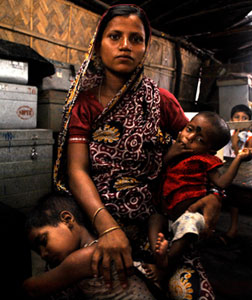The Best Dollar You Will Ever Spend
Nobel laureates have figured out the eight investments that will help the planet most. No. 1: micronutrients.

On the eastern edge of Kolkata, India, Dulu Bibi, a 25-year-old mother of four, worries about the cost of treating her two sick boys. Her husband earns 80-90 rupees ($1.90) a day. The family's basic diet is low in the essential micronutrients that children need to thrive. Dulu's two sons, age 3 and 1, are weak and feverish, lack appetite, and cry a lot. "If I have to spend 150-200 rupees on medicine," she asks, "what will I eat and feed my children with?"
Dulu's story is heartbreakingly common in the developing world: 3 billion people survive on diets that lack micronutrients such as Vitamin A and Zinc, and are at increased risk of illness from common infections such as diarrheal disease, which kills nearly 2 million children annually.
Micronutrient deficiency is known as "hidden hunger." This is a fitting description, because it is one of the global challenges that we hear relatively little about in the developed world. It draws scant media attention or celebrity firepower, which are often crucial to attracting charitable donations to a cause.
But there is a larger point here: Billions of dollars are given and spent on aid and development by individuals and companies each year. Despite this generosity, we simply do not allocate enough resources to solve all of the world's biggest problems. In a world fraught with competing claims on human solidarity, we have a moral obligation to direct additional resources to where they can achieve the most good. And that is as true of our own small-scale charitable donations as it is of governments' or philanthropists' aid budgets.
In 2008, the Copenhagen Consensus Center, which I direct, asked a group of the world's top economists to identify the "investments" that could best help the planet. The experts—including five Nobel laureates—compared ways to spend $75 billion on more than 30 interventions aimed at reducing malnutrition, broadening educational opportunity, slowing global warming, cutting air pollution, preventing conflict, fighting disease, improving access to water and sanitation, lowering trade and immigration barriers, thwarting terrorism, and promoting gender equality.
Guided by their consideration of each option's costs and benefits, and setting aside matters like media attention, the experts identified the best investments: those for which relatively tiny amounts of money could generate significant returns in terms of health, prosperity, and community advantages. These included: increased immunization coverage, initiatives to reduce school dropout rates, community-based nutrition promotion, and micronutrient supplementation.
This last initiative, which could do so much to help Dulu Bibi's family in Kolkata, is extraordinarily cheap. Providing Vitamin A for a year costs as little as $1.20 per child, while providing Zinc costs as little as $1.
Bjørn Lomborg on How To Make Giving Count
By highlighting the areas in which even small investments can accomplish a great deal, the project influenced philanthropic organizations and governments. This month, the Copenhagen Consensus Center releases the Guide to Giving, so that those of us without a government treasury or charitable foundation at our disposal can also consider how to use the experts' lessons. (Read here about the eight initiatives where the Nobel laureates believe that very small investments could achieve significant benefits.)
Some reject the need to set priorities. But it happens whether we like it or not. A few causes and issues get the most airtime, attention, and money. The Copenhagen Consensus provides a framework on which we can build informed decisions, based on what can be achieved with similar "investments" in different areas.
Should we contribute to organizations that focus on saving lives today, immediately making the world a better place (with spin-offs lasting longer), or fund education to benefit future generations?
Often we hear catchphrases like "without an education there is no future" or "without water one cannot survive," as if it is obvious that we should focus first on one or the other. But many people go without proper education and access to clean drinking water. The difficult task that the expert panel undertook was to look at the extra good that an additional donation—even as little as $10—could achieve with respect to many good causes.
The contrast between saving lives today and aiming at tomorrow becomes clear when efforts to tackle global warming are included in the comparison. How could $10 best be spent? Should we, say, buy carbon offsets, or donate to a charity providing micronutrient supplements?
By putting all benefits to individuals, communities, and countries in monetary terms, we can compare the two options. Expert researchers for the Copenhagen Consensus found that carbon offsets are a relatively ineffective way of reining in global warming and reducing its effects—$10 would avoid about $3 of damage from climate change. By contrast, $10 spent on Vitamin A supplements would achieve more than $170 of benefits in health and long-term prosperity.
One lesson we can draw is that while global warming may exacerbate problems like malnutrition, communities bolstered by adequate nutrition will generally be less vulnerable to climate-based threats. Overall, we can typically best help through direct interventions, including micronutrient supplements, fortification, biofortification, and nutritional promotion.
There are billions of stories like Dulu Bibi's that demand our attention. By embracing simple lessons from economics, all of us—individuals, governments, and philanthropies—can ensure that our generosity yields the greatest benefit possible.
This article comes from Project Syndicate.
